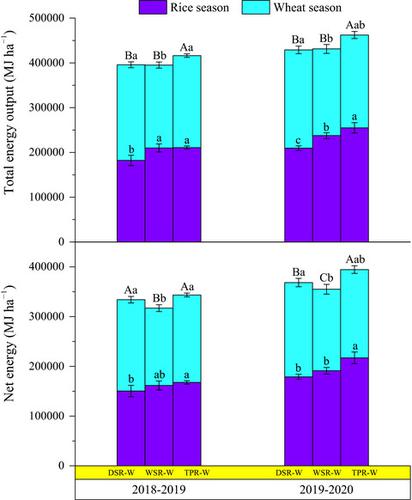当前位置:
X-MOL 学术
›
Food Energy Secur.
›
论文详情
Our official English website, www.x-mol.net, welcomes your
feedback! (Note: you will need to create a separate account there.)
Energy assessment of different rice–wheat rotation systems
Food and Energy Security ( IF 4.0 ) Pub Date : 2021-04-04 , DOI: 10.1002/fes3.284 Zhaoqiang Jin 1 , Li Zhang 1 , Hongyan Liu 1 , Lixiao Nie 1
Food and Energy Security ( IF 4.0 ) Pub Date : 2021-04-04 , DOI: 10.1002/fes3.284 Zhaoqiang Jin 1 , Li Zhang 1 , Hongyan Liu 1 , Lixiao Nie 1
Affiliation

|
Food and energy security are important issues that threaten human survival and development. The rice–wheat rotation system provides a stable source of food for more than 20% of the world's population, but there have been no reports on the energy balance of different rice–wheat rotation systems. This study evaluates the energy inputs and outputs of three rice–wheat rotation systems and their energy production efficiency through the study of dry direct‐seeded, wet direct‐seeded, and transplanted rice–wheat rotation systems. The results of the study showed that the average total energy inputs in the dry direct‐seeded, wet direct‐seeded, and transplanted rice–wheat rotation systems were 58,677, 74,083, and 69,022 MJ ha−1, respectively. The production resources with more energy input in rice–wheat rotation system were all related to water and fertilizer. The energy input in the rice season accounts for more than 50.69% of the total energy input in the rice–wheat rotation system. At the same time, rice–wheat rotation production is highly dependent on nonrenewable energy. Among the three rice–wheat rotation systems, the transplanted rice–wheat rotation system had the highest total energy output and net energy, while the dry direct‐seeded rice–wheat rotation had the highest energy use efficiency, energy productivity, energy profitability, and human energy profitability. The results showed that the key to reducing the energy input in the rice–wheat rotation system is to reduce the amount of water and fertilizer. The transplanted rice–wheat rotation system is more suitable for promotion in rice–wheat rotation production areas with good irrigation conditions, while the dry direct‐seeded rice–wheat rotation system is highly compatible with the current development direction of low energy consumption and high energy efficiency in agricultural production and is suitable for promotion in rice–wheat production areas with poor irrigation conditions.
中文翻译:

不同稻麦轮作系统的能量评估
粮食和能源安全是威胁人类生存和发展的重要问题。稻麦轮作系统为世界20%以上的人口提供了稳定的食物来源,但尚无关于不同稻麦轮作系统能量平衡的报道。这项研究通过研究干式直接播种,湿式直接播种和移植的稻麦小麦轮作系统,评估了三种稻麦轮作系统的能量输入和输出以及它们的能源生产效率。研究结果表明,在干式直播,湿式直播和移植的稻麦轮作系统中,平均总能量输入为58,677、74,083和69,022 MJ ha -1, 分别。稻麦轮作系统中投入更多能量的生产资源都与水和肥料有关。稻米季节的能量输入占稻麦轮作系统总能量输入的50.69%以上。同时,稻麦轮作生产高度依赖不可再生能源。在这三个稻麦轮作系统中,移植的稻麦轮作系统具有最高的总能量输出和净能量,而干式直播稻麦轮作具有最高的能源利用效率,能源生产率,能源获利能力和可再生能源。人力能源获利能力。结果表明,减少稻麦轮作系统中能量输入的关键是减少水和肥料的用量。
更新日期:2021-05-12
中文翻译:

不同稻麦轮作系统的能量评估
粮食和能源安全是威胁人类生存和发展的重要问题。稻麦轮作系统为世界20%以上的人口提供了稳定的食物来源,但尚无关于不同稻麦轮作系统能量平衡的报道。这项研究通过研究干式直接播种,湿式直接播种和移植的稻麦小麦轮作系统,评估了三种稻麦轮作系统的能量输入和输出以及它们的能源生产效率。研究结果表明,在干式直播,湿式直播和移植的稻麦轮作系统中,平均总能量输入为58,677、74,083和69,022 MJ ha -1, 分别。稻麦轮作系统中投入更多能量的生产资源都与水和肥料有关。稻米季节的能量输入占稻麦轮作系统总能量输入的50.69%以上。同时,稻麦轮作生产高度依赖不可再生能源。在这三个稻麦轮作系统中,移植的稻麦轮作系统具有最高的总能量输出和净能量,而干式直播稻麦轮作具有最高的能源利用效率,能源生产率,能源获利能力和可再生能源。人力能源获利能力。结果表明,减少稻麦轮作系统中能量输入的关键是减少水和肥料的用量。











































 京公网安备 11010802027423号
京公网安备 11010802027423号